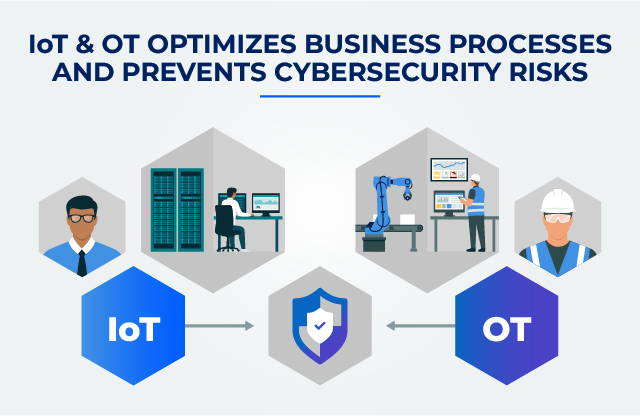Overview
The Internet of Things (IoT) utilizes the Internet to connect various elements and devices to communicate with similar devices. Unlike IoT, operational technology (OT) monitors and controls devices, physical processes, and infrastructure by using appropriate hardware and software. IoT and OT security services enable you with targeted solutions to safeguard the IoT and OT business infrastructure. Both IoT and OT create a security ecosystem to detect cyber threats and mitigate potential cyber risks. The cybersecurity experts facilitate and strengthen overall business security through IoT and OT.
Need for IoT and OT solutions
Organizations in the global arena are experiencing an enormous rise in the use of Internet-connected devices. With the wide use of these devices, organizations tend to transfer voluminous data and communicate within networks. The data communication can be on-premises or cloud-based. While organizations are greatly benefited by this data transfer and communication across multiple networks, there is an increase in cyber threats and data breaches.
Internet-connected devices may comprise manufacturing equipment, healthcare equipment monitoring real-time data, or Wi-Fi-enabled setups used by various business sectors. As the world progressively connects, the connections become more susceptible to potential cyberattacks by cybercriminals. In some cases, cyber risks are unidentified, while in other cases, these risks are ignored due to a lack of the required skills. But the Internet-connected devices and the associated connections must be secured from frequent cyberattacks.
Internet of Things (IoT) in the cybersecurity domain
The term Internet of Things (IoT) refers to a system of devices and sensors that are interconnected to collect and exchange data across varied networks. There are different types of IoT devices, ranging from simple sensors to complex devices. The prime objective of IoT devices is not only to collect data but also to control and monitor them. Moreover, IoT devices can be used for managing and tracking data collected by various Internet-connected devices.
As the number of devices connected to the Internet increases, the data becomes widely available for potential cyber risks through ransomware. Thus, it is vital for organizations to safeguard IoT devices and avoid falling victim to cyberattacks. The organizations need to develop and manage the hardware as well as the software to maintain the IoT devices.
IoT cybersecurity is one of the major challenges faced by organizations. IoT devices enable an easier pathway for cybercriminals to execute Distributed Denial-of-Service (DDoS) attacks, perhaps with the help of botnets. A botnet includes a large number of devices under the control of cybercriminals. Most of the data breaches are due to these botnets.
Yet another cybersecurity risk includes the use of IoT devices to introduce newer forms of malware. Many of the cyberattacks observed are due to malware compromises within the organizations. The service network providers as well as the cloud providers for most of the financial organizations are at greater risk.
IoT-related cybersecurity threats
Some of the common types of IoT-related cybersecurity threats include:
- Data theft: This cybersecurity threat occurs due to improper access to personally identifiable information (PII), for example, user names, user accounts, social security numbers, national health card numbers, contact numbers, and addresses.
- Data or service manipulation: Here, the cybercriminal makes random modifications to the settings of an IoT device. This can lead to data loss, loss of service, damage to the device, or damage to other connected devices.
- Non-compliance: This threat is due to the non-compliance practices as governments enact laws to protect privacy and enforce cybersecurity. For example, the IoTs Cybersecurity Improvement Act of 2020 prohibits organizations from using IoT devices after Dec. 4, 2022. This is in accordance with the standards developed by the National Institute of Standards and Technology (NIST).
- Service disruption: This cybersecurity threat manipulates the IoT device(s) and makes an essential service completely unavailable for the IoT device or the connected devices.
Operational Technology (OT) in the cybersecurity domain
Operational technology (OT) in the cybersecurity domain comprises the detection, monitoring, and remediation processes involved in managing the network-connected OT devices affected by any unusual system performance. In other words, it refers to the network-connected OT devices used for monitoring or controlling processes that are outside the Information Technology (IT) domain.
There has been an increase in the use of OT devices, leading to the urgency of making OT cybersecurity one of the vital components. As per Ponemon Cyber Security, the Operational Technology Report (2019), states that more than 60% of the cyberattacks are attacks against the operational technology (OT) domain.
The limitation with OT cybersecurity is mainly due to devices running outdated software or lacking the latest security patches. This limitation becomes an opportunity for cybercriminals and leads to security compromise as they are able to infect and disrupt the system with malware. For example, in 2020, new malware resulting in cyberattacks on OT devices running embedded Windows 7 disrupted the systems to a great extent. As per the Global Risk Report (2020), OT security organization CyberX removed support and patches for Windows XP and Windows 2000 systems.
Importance of OT cybersecurity
The importance of OT cybersecurity must not be overlooked for the following reasons:
- Business process continuity: with a constant pace in business operations, organizations need to optimize their data transfer and communication processes. Business process continuity cannot be compromised at any cost. The downtime processes not only cause client inconvenience but also damage the organization’s reputation. OT in the cybersecurity domain guarantees that the business processes resume smooth operations and accomplish an uninterrupted business flow.
- Safeguarding against cyberattacks: Operational technology in the security domain enables timely detection of system changes. OT provides a safeguard approach by not only monitoring the cyberattacks but also preventing them. Accordingly, OT provides a safeguard approach by monitoring the cyberattacks and preventing them.
With the accelerated growth of IoT and the convergence of IT and OT, business processes are optimized to a great extent.

IoT and OT optimizes business processes.
- OT has enabled networks with security based on exclusive protocols and software. It is largely used for monitoring and administering the optimized functioning of the systems, thereby avoiding potential risks. Conventionally, IT is separated from OT, but as of now, both are connected with each other and the Internet. As a collective measure, both IT and OT converge to provide smarter analytics, enabling organizations to gain a specific view of their business processes.
- Accessing network communication for OT and IoT has some challenges to overcome. Earlier, business processes were not easy targets for cybercriminals. The processes were restricted and closed to the Internet. Due to the integration of OT and IoT, organizations are focusing on cybersecurity. Cybersecurity for OT and IoT protects information and systems from cyber threats and data breaches.
- An alarming increase in the rate of Internet connections has outpaced organizational capabilities to safeguard them. While many organizations have established advanced processes and controls for protecting and securing their IT networks and systems, OT and IoT networks are often unnoticed. This makes the OT and IoT networks vulnerable to cyberattacks.
- Organizations can prevent cyberattacks from impacting critical business processes and their valuable reputations. It can be achieved through the timely identification and classification of vulnerabilities across network devices. This will not only enable better visibility but also stricter control over these vulnerabilities.
Other Blogs

From Nuclear Centrifuges To Machine Shops: Securing IoT
IoT or ‘the internet of things’ has been around for a lot longer than the buzzword
Read More


Demystifying XDR
As the capabilities of threat actors have increased so have the tools which we utilize to detect and respond to their activities.
Read More


Cybersecurity In A Post Pandemic World
As many cyber security practitioners will tell you, the most imminent and dangerous threat to any network are the employees accessing it.
Read More


